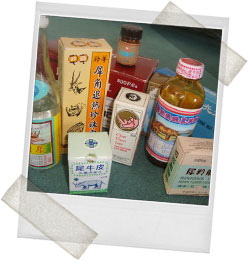

Traditional Medicines have been used for centuries and it is thought that currently around 80% of the worlds population rely on them as their main source of treatment for ailments. Traditional Chinese Medicine (TCM) is one sector of Asian medicines which uses many substances derived from plants, animals and minerals.
Traditional Chinese Medicine is fundamentally different from Western medicine. Instead of concentrating on the targeted treatment of symptoms, TCM uses a holistic approach for the diagnosis, prevention and treatment of ailments and diseases.
The origins of Chinese medicine have grown from the observation of the natural world and how it works (Daoism), and the theories of yin and yang and the five elements.
yin and yang put simply are the opposite sides which exist in the universe, they are separate from each other, and conflicting, but one side cannot exist without the other. Examples include light and dark, cold and warm, slow and fast and masculine and feminine. In the human body, Yin elements are described as those which are ‘still, dark, descending and hypoactive’, whereas Yan elements are ‘moving, bright, ascending and hyperactive’. yin and yang constantly change and balance is required. It is believed that once balance is disrupted in the human body, disease occurs.
The five elements (Wood, Fire, Earth, Metal, Water) and the relationships between them are used in TCM to interpret the relationship between the human body and the natural environment. It is believed that the organs of the body have similar properties to the five elements, interacting in the same way as in nature, and for good health a balanced relationship between the body’s elements is required.
TCM treats the human body as its core organs and tissues, connected by a network of channels and blood vessels. Chi (Qi) is the information expressed by a person; some describe this as a type of energy. Ailments are expressed and TCM analyses the whole system, working out how to readjust functions and processes of the body. TCM is a complex system which in simple terms aims to evaluate the cause, location and nature of a problem, and then treat the ailment and the body’s resistance to it.
This type of medicine is deeply rooted not only in Chinese culture but also globally. Many holistic and complimentary therapies have grown both from and alongside traditional medicines and are used all over the World. Traditional medicines are what is available or the choice for many people. Others choose to believe that Western medicine based on scientific proof is what works. Some may choose to use both scientific and complimentary therapies.
 Pre-ban rhino horn TCM packaging
Pre-ban rhino horn TCM packagingSo what is the problem? There are more than 6 billion people on the planet and it is a fact that resources are being used at an unsustainable rate. Where do traditional medicines fit in here? Sadly many plant and animal species believed to have properties useful for traditional medicines are now hugely depleted in numbers, and we are at risk of losing many species all together. Today, the use of endangered species in traditional medicines is simply not acceptable. There are alternatives which have been proven effective and there are alternative natural substances which have the same properties as those from the body parts of endangered animals. Studies have shown that rhino horn has no medicinal properties, but, buffalo horn is an alternative for rhino horn, and has been used and accepted by many TCM users and practitioners, and can be harvested sustainably.
There has been much progress within the TCM community and in 1993 the Ministry of Health of the People’s Republic of China removed rhino horn from the Chinese Medicine Pharmacopeia. The Register of Chinese Herbal Medicine (RCHM) in the UK has condemned the illegal trade in endangered species and made it clear they have a strict policy prohibiting the use of any type of endangered species by any of its members. The RCHM states that rhino horn is not considered to be a medicinal ingredient, and herbal substitutes are readily available.
Sadly endangered species are still being targeted for traditional medicines all over the world, and numbers of some of our most iconic animals are continuing to decline for this very reason. Traditional medicines which are ecologically responsible are those which are to be supported.
Traditional medicines have developed from observing the natural world, the theory of yin and yang and the balance of the elements. In addition to many other reasons, surely the continued use of medicines which contain endangered species is fundamentally flawed: it is vitally important that balance on Earth and within ecosystems is maintained. Driving a species to extinction is not an action which promotes equilibrium and the health of the universe.
Links: